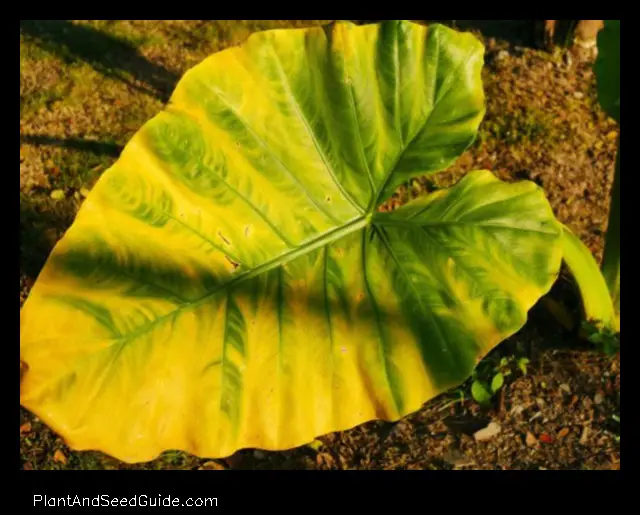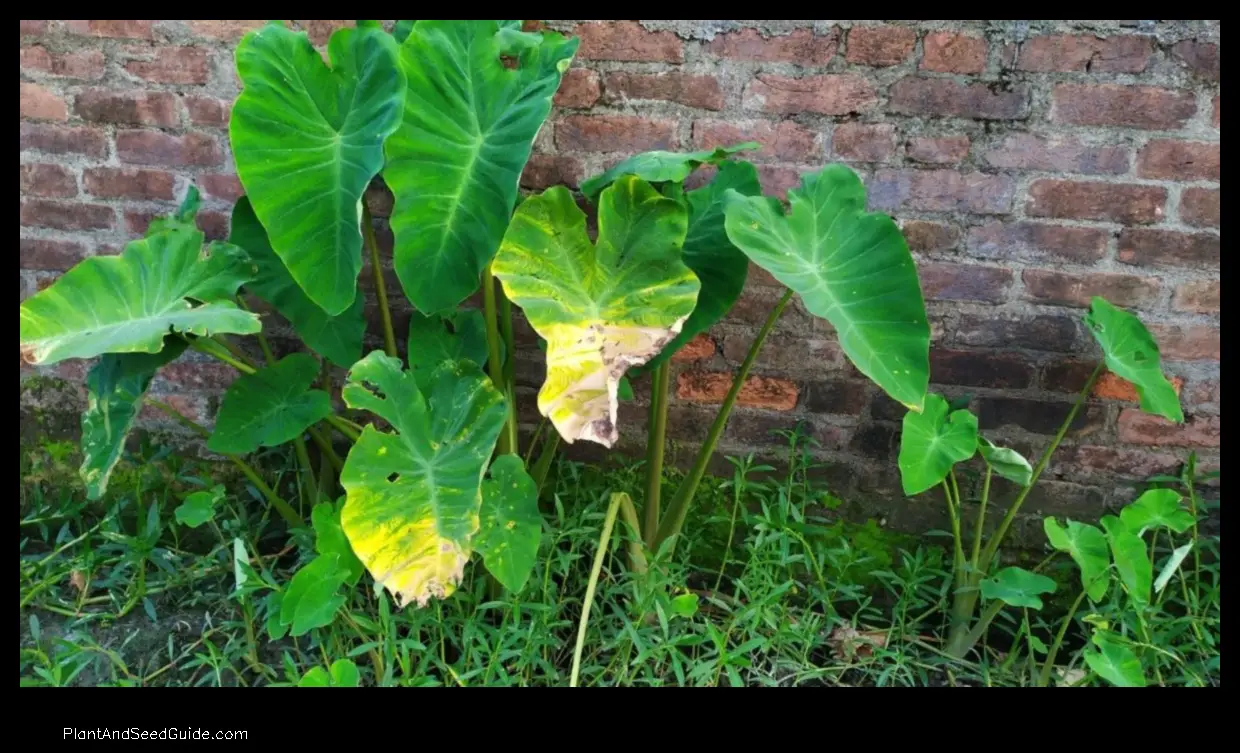

Why is my elephant ear plant turning yellow?
Why is my elephant ear plant turning yellow?
There are a few possible reasons why your elephant ear plant is turning yellow.
- Overwatering
- Underwatering
- Too much fertilizer
- Not enough sunlight
- A pest infestation
- A disease
To determine the cause of the yellowing leaves, you will need to inspect your plant and consider the growing conditions.
How to fix a yellowing elephant ear plant
Once you have determined the cause of the yellowing leaves, you can take steps to fix the problem.
- If you are overwatering your plant, reduce the amount of water you are giving it.
- If you are underwatering your plant, increase the amount of water you are giving it.
- If you are using too much fertilizer, stop fertilizing your plant for a few months.
- If your plant is not getting enough sunlight, move it to a brighter location.
- If your plant has a pest infestation, treat it with an insecticide or insecticidal soap.
- If your plant has a disease, treat it with a fungicide.
By following these steps, you can help your elephant ear plant recover from yellowing leaves and keep it healthy.
Loading... Seconds Left for
Miniature Orchid Terrarium Gallery!

Common causes of yellowing elephant ear plants
The most common causes of yellowing elephant ear plants are:
- Overwatering
- Underwatering
- Too much fertilizer
- Not enough sunlight
- A pest infestation
- A disease</li>
Let’s take a closer look at each of these causes.
Overwatering
Elephant ear plants are susceptible to root rot if they are overwatered. Root rot is a fungal disease that can cause the roots of the plant to decay. This can lead to yellowing leaves and eventually the death of the plant.
To avoid ov
erwatering your elephant ear plant, make sure to only water it when the soil is dry to the touch. You can also check the moisture level of the soil by inserting a finger into the pot. If the soil is moist, you do not need to water the plant.
Underwatering
Elephant ear plants also need to be watered regularly to prevent them from drying out. If your elephant ear plant is underwatered, the leaves will start to turn yellow and wilt.
To avoid underwatering your elephant ear plant, make sure to water it regularly. You should water the plant until the water runs out of the drainage holes in the bottom of the pot.
Elephant ear plants do not need a lot of fertilizer. If you fertilize your plant too often, the leaves can start to turn yellow.
To avoid fertilizing your elephant ear plant too much, only fertilize it once a month during the growing season. You should also use a fertilizer that is specifically designed for houseplants.
Not enough sunlight
Elephant ear plants need a lot of sunlight to thrive. If your elephant ear plant is not getting enough sunlight, the leaves will start to turn yellow.
To provide
your elephant ear plant with enough sunlight, place it in a bright location that receives direct sunlight for at least 6 hours a day.
Pest infestation
Elephant ear plants can be susceptible to a variety of pests, including aphids, mealybugs, and scale insects.
| Topic |
Answer |
| Why is my elephant ear plant turning yellow? |
There are a number of reasons why your elephant ear plant may be turning yellow. Some of the most common causes include: |
| How to fix a yellowing elephant ear plant? |
Once you have determined the cause of the yellowing leaves, you can take steps to fix the problem. Some of the most common solutions include: |
| Common causes of yellowing elephant ear plants |
The following are some of the most common causes of yellowing elephant ear plants: |
| How to prevent your elephant ear plant from turning yellow |
There are a number of things you can do to prevent your elephant ear plant from turning yellow. Some of the most important tips include: |
| Tips for caring for elephant ear plants |
Elephant ear plants are relatively easy to care for, but there are a few things you can do to ensure that they stay healthy and vibrant. Some of the most important tips include: |
Why is my elephant ear plant turning yellow?
There are a few reasons why your elephant ear plant might be turning yellow.
Overwateri
ng: Elephant ear plants are susceptible to overwatering, which can cause the roots to rot and the leaves to turn yellow. Make sure to only water your elephant ear plant when the soil is dry to the touch.
Underwatering: Elephant ear plants also need to be watered regularly, but they can also be harmed by underwatering. If your elephant ear plant’s leaves are turning yellow, it might be because it’s not getting enough water.
Too much sun: Elephant ear plants prefer bright, indirect sunlight. If your elephant ear plant is getting too much direct sunlight, its leaves can burn and turn yellow.
Not enough sun: Elephant ear plants also need some sunlight to thrive. If your elephant ear plant is not getting enough sunlight, its leaves can turn yellow.
Nutrient deficiency: Elephant ear plants need a variety of nutrients to stay healthy. If your elephant ear plant is not getting enough nutrients, its leaves can turn yellow.
Disease: Elephant ear plants can be affected by a variety of diseases, which can cause the leaves to turn yellow. If you think your elephant ear plant might have a disease, it’s best to take it to a professional for diagnosis and treatment.
Common causes of yellowing elephant ear plants
There are a number of reasons why your elephant ear plant may be turning yellow. Here are some of the most common causes:
- Overwatering: Elephant ear plants are susceptible to root rot if they are overwatered. This can cause the leaves to turn yellow and eventually fall off.
- Underwatering: Elephant ear plants also need to be watered regularly, but they can be just as susceptible to damage if they are underwatered. This can cause the leaves to wilt and turn yellow.
- Drought stress: Elephant ear plants are native to tropical climates and they do not tolerate drought well. If your plant is not getting enough water, the leaves may turn yellow.
- Too much sun: Elephant ear plants need bright light, but they can be damaged if they are exposed to too much direct sunlight. This can cause the leaves to turn yellow and eventually burn.
- Not enough sun: Elephant ear plants also need some shade, especially during the hottest part of the day. If your plant is not getting enough light, the leaves may turn yellow.
- Nutrient deficiency: Elephant ear plants need a number of nutrients in order to stay healthy. If your plant is not getting enough nutrients, the leaves may turn yellow.
- Disease: Elephant ear plants can be susceptible to a number of diseases, including fungal diseases and bacterial diseases. These diseases can cause the leaves to turn yellow and eventually die.
n id="Why_is_my_elephant_ear_plant_turning_yellow-3">Why is my elephant ear plant turning yellow?
There are a number of reasons why your elephant ear plant may be turning yellow. Some of the most common causes include:
Overwatering: Elephant ear plants are susceptible to root rot if they are overwatered. This can cause the leaves to turn yellow and eventually die.
Underwatering: Elephant ear plants also need to be watered regularly, but they can also suffer if they are underwatered. This can cause the leaves to wilt and turn yellow.
Incorrect lighting: Elephant ear plants need bright, indirect sunlight in order to thrive. If they are not getting enough light, their leaves will start to turn yellow.
Nutrient deficiency: Elephant ear plants need a number of nutrients in order to grow and thrive. If they are not getting enough nutrients, their leaves may start to turn yellow.
Pests or diseases: Elephant ear plants can be susceptible to a number of pests and diseases, which can cause their leaves to turn yellow.
Why is my elephant ear plant turning yellow?
There are a number of reasons why your elephant ear plant may be turning yellow. The most common causes are:
- Overwatering
- Underwatering
- Too much fertilizer
- Too little fertilizer
- Lack of sunlight
- Too much sunlight
- Insect infestation
- Disease
To determine the cause of the yellowing leaves, you will need to examine your plant carefully and consider the environmental conditions in which it is growing.




